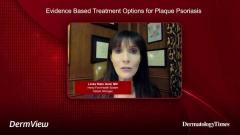
Tapinarof: Plaque Psoriasis Phase III Trial Overview
Linda Stein Gold, MD, reviews phase III data for the topical agent tapinarof for the treatment of plaque psoriasis.
Episodes in this series

LindaStein Gold, MD: I’mgoing to move on because we have another new nonsteroidal topical that was FDA-approved. This is a cream formulation that is used once a day called, tapinarof, another new small molecule that works inside the cell. It's an oral hybrid hydrocarbon reductase agonist. People will say, "Oh my gosh, what in the world is happening with that?" In terms of the mechanism of action, there are several different things. We say that this receptor is ligand-dependent. It acts different ways depending on who is binding to it. When tapinarof binds to this receptor, we see a downregulation of Th17 cytokines, which is important for psoriasis. We see a decrease in oxidative stress, we see an improvement in skin barrier proteins, and we also see a downregulation of Th2 cytokines. We're not talking about atopic dermatitis here, but both roflumilast and tapinarof are currently in phase 3 clinical trials for atopic dermatitis. Jennifer, I know that you know a lot about the tapinarof phase 3 studies. Can you walk us through what happened there?
Jennifer Soung, MD: I find tapinarof to be fascinating in terms of the mechanism of action. This is completely new to us in dermatology. The active ingredient was isolated from the small intestines of a roundworm. It's very interesting how it can work on different areas of the immune system to heal different inflammatory rashes, and even improve the skin barrier. I've had experience in the phase 2 development program, so we're talking about the phase 3. In the phase 3 program, they looked specifically at adult patients with plaque psoriasis. In topical studies, they included a range of severity levels from mild, moderate, to severe. The body surface area was as little as 3% up to 20%. There were 2 identical phase 3 studies. It was a straightforward design with tapinarof 1% once daily versus vehicle, and the primary endpoint they looked at was a physician's global assessment. Your PGA response defined as a 0 or 1. Again, this was a 2-grade improvement. Here, we're looking at week 12. I highlight that because I want to set our patients expectations. We want to make sure that they don't stop using this topical before it has a chance to work. To just give you an idea of the type of patients in this study, the majority were your moderate plaque psoriasis patients, which is that red classic scaly plaque. They also had about 8% of patients that were severe. I'm always so curious at how severe patients are going to respond because I'll have patients who are already on a systemic, and they have 1 stubborn plaque left and they've tried the high-potency topical steroids. I'm always looking for a new mechanism of action.
LindaStein Gold, MD: Jennifer, you mentioned that they had mild, moderate, and severe. It's so important because the moderate is the sweet spot because moderate patients get to go to clear, or almost clear. With those mild patients, they have to get all the way to completely clear, and that means there can't be a touch of pink skin left on that body. The severe patients have to go all the way to almost clear. That's 3 or 4 grades. These are high bars for those mild and those severe patients. We saw it in the roflumilast, which included a broad range. That's something new. In the past, we didn't want to include a lot of milds because it was so tough. We wanted to definitely limit our severe patients.
Jennifer Soung, MD: There are really impressive results at week 12, where you have about 35% to 40% of patients who are clear after using tapinarof 1% once daily. It was a homerun. You know when your active agent is working because your placebo group is just so low.
Transcript edited for clarity
Newsletter
Like what you’re reading? Subscribe to Dermatology Times for weekly updates on therapies, innovations, and real-world practice tips.






















